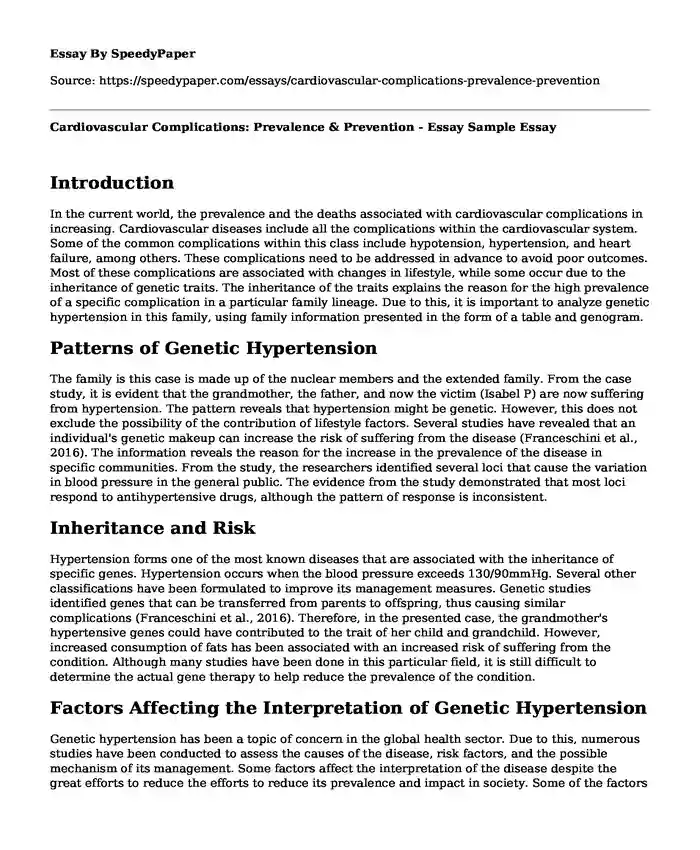
| Type of paper: | Essay |
| Categories: | Medicine Healthcare |
| Pages: | 3 |
| Wordcount: | 656 words |
Introduction
In the current world, the prevalence and the deaths associated with cardiovascular complications in increasing. Cardiovascular diseases include all the complications within the cardiovascular system. Some of the common complications within this class include hypotension, hypertension, and heart failure, among others. These complications need to be addressed in advance to avoid poor outcomes. Most of these complications are associated with changes in lifestyle, while some occur due to the inheritance of genetic traits. The inheritance of the traits explains the reason for the high prevalence of a specific complication in a particular family lineage. Due to this, it is important to analyze genetic hypertension in this family, using family information presented in the form of a table and genogram.
Patterns of Genetic Hypertension
The family is this case is made up of the nuclear members and the extended family. From the case study, it is evident that the grandmother, the father, and now the victim (Isabel P) are now suffering from hypertension. The pattern reveals that hypertension might be genetic. However, this does not exclude the possibility of the contribution of lifestyle factors. Several studies have revealed that an individual's genetic makeup can increase the risk of suffering from the disease (Franceschini et al., 2016). The information reveals the reason for the increase in the prevalence of the disease in specific communities. From the study, the researchers identified several loci that cause the variation in blood pressure in the general public. The evidence from the study demonstrated that most loci respond to antihypertensive drugs, although the pattern of response is inconsistent.
Inheritance and Risk
Hypertension forms one of the most known diseases that are associated with the inheritance of specific genes. Hypertension occurs when the blood pressure exceeds 130/90mmHg. Several other classifications have been formulated to improve its management measures. Genetic studies identified genes that can be transferred from parents to offspring, thus causing similar complications (Franceschini et al., 2016). Therefore, in the presented case, the grandmother's hypertensive genes could have contributed to the trait of her child and grandchild. However, increased consumption of fats has been associated with an increased risk of suffering from the condition. Although many studies have been done in this particular field, it is still difficult to determine the actual gene therapy to help reduce the prevalence of the condition.
Factors Affecting the Interpretation of Genetic Hypertension
Genetic hypertension has been a topic of concern in the global health sector. Due to this, numerous studies have been conducted to assess the causes of the disease, risk factors, and the possible mechanism of its management. Some factors affect the interpretation of the disease despite the great efforts to reduce the efforts to reduce its prevalence and impact in society. Some of the factors include limited information on the genetic linkages that may help in the formulation of targeted therapies (Ahn & Gupta, 2018). The second factor is the high association between the genetic factors and the environmental risk factors. These two factors affect the interpretation of the genetic data that may help in improving genetic hypertension management.
Conclusion
In conclusion, genetic hypertension is a cardiovascular disorder that is caused by the inheritance of specific genes. These genes have been associated with altered blood pressure in specific communities. A lot of studies have been done on the topic to identify the actual gene loci that cause the disease. These studies have helped in improving the scientific knowledge about the disease and thus enhancing the management measures. However, lack of adequate information on genetic linkages and the interaction of the genetic environment factors affect the interpretation of the disease. Therefore, this increases the risk of the progression of the disease in the family.
References
Ahn, S., & Gupta, C. (2018). Genetic Programming of Hypertension. Frontiers In Pediatrics, 5. https://doi.org/10.3389/fped.2017.00285
Franceschini, N., Chasman, D., Cooper-DeHoff, R., & Arnett, D. (2016). Genetics, Ancestry, and Hypertension: Implications for Targeted Antihypertensive Therapies. Current Hypertension Reports, 16(8). https://doi.org/10.1007/s11906-014-0461-9
Cite this page
Cardiovascular Complications: Prevalence & Prevention - Essay Sample. (2023, Aug 16). Retrieved from https://speedypaper.com/essays/cardiovascular-complications-prevalence-prevention
Request Removal
If you are the original author of this essay and no longer wish to have it published on the SpeedyPaper website, please click below to request its removal:
- Case Study Essay Example: Sepsis/SIRS
- Paper Example - Acceptance and Commitment Therapy
- Paper Example. Regression Analysis Discussion Post
- Postpartum Depression: Adverse Effects on Spouses and Child Development - Essay Sample
- Unraveling the Coagulation Cascade: A Comprehensive Exploration of Von Willebrand Disorder - Essay Sample
- Social Media and Its Impact on Mental Health - Free Paper Example
- Nursing Leadership Excellence: Coordinating Healthcare Delivery for Quality and Safety - Essay Sample
Popular categories




